IDEARR Model for STEM Education—A Framework Proposal
Abstract
:1. Introduction
2. STEM Education and Its Epistemological Fit
- Ortiz-Revilla et al. [18] argue that NoSTEM should be understood figuratively to ensure proper disciplinary integration and to teach an “integrated nature of integrated STEM”. Thus, while they acknowledge that NoSTEM does not exist in theory because STEM education is not a discipline, it does have a practical expression that underlies the transdisciplinary integration of STEM disciplines.
- Quinn et al. [17] understand that, also in a figurative sense, NoSTEM is manifested through the Nature of Engineering (NoE).
- McComas and Burgin [16] assert that NoSTEM does not exist and also question the relevance of Technology in the acronym, as they do not consider it a discipline.
- Akerson et al. [13] assume that NoSTEM does not exist but admit that there are individual natures (NoS, NoT, NoE, and NoM) that interact to construct an integrated educational approach.
- The philosophy and history of Science, Technology, Engineering, and Mathematics, along with the body of knowledge of each, provide thought patterns that allow for a critical analysis of the role that each STEM discipline can adopt in the resolution of an authentic and complex problem.
- Psychopedagogical elements, both general (e.g., educational theories, cognitive development…) and specific (e.g., science education, technology education…), enable the didactic transposition of disciplinary elements.
- The curriculum provides legislative support for the implementation of STEM education.
- Social elements participate in the construction and resolution of the problematic situation, which has been identified as a key characteristic of STEM education [12]. This encourages other disciplines to be linked to this approach in a crosscutting manner. For example, Linguistics can provide frameworks for analyzing discourse and preparing research reports; Ethics provides a framework for interpreting the moral aspects inherent in the chosen issue; and Art can offer a framework for evaluating the choice among different alternatives for a product based, for instance, on aesthetic aspects.
2.1. Disciplinary System
- Science as a “form of knowledge” that seeks to understand the world around us.
- Technology as a “form of adaptation” that necessarily considers social impacts.
- Engineering as a “way of designing/creating devices” to respond to real problems.
- Mathematics as a “way of expressing an understanding/analysis of the world and problems through numbers”.
- STEM disciplines share some characteristics in their knowledge and practices (overlaps) while also displaying peculiarities [17,18]. This facilitates their integration but also presents a challenge. Therefore, when implementing STEM education, the practices and characteristics of knowledge specific to each discipline should not be neglected.
- Technology and Engineering exhibit significant overlaps that make their disciplinary distinction challenging [17], to the extent that some authors do not consider Technology a discipline [16]. However, Technology has nuances, albeit few and still lacking consensus, which differentiate it from Engineering. While Technology focuses on assessing the social—we extend it to environmental—impact of technological elements and systems [35], Engineering is centered on producing them [17,32]. Thus, Technology constitutes a discipline linked to the study of human needs within a specific social and environmental context, while Engineering is a discipline aimed at the production of artifacts to solve real, specific problems based on human needs [30].
- Science, Technology, and Engineering constantly interact (bidirectional relationships), which is why the development of one is linked to the others [37,38]. In contrast, Mathematics does not have such a high level of interaction (unidirectional relationships) with the other STEM disciplines. This could explain, a priori, the support role that Mathematics tends to play when integrated with the other STEM disciplines [7,39,40,41] and the inclusion of mathematical content in STEM educational proposals that require low cognitive demands [42]. Becker and Park [43] suggest that sequential integration, guided by a thematic axis or context, leads to better performance in Mathematics and a better understanding of NOM, compared to parallel or total integration of the disciplines. Therefore, it is advisable for the STEM approach to highlight the contribution of Mathematics to the other disciplines and problem solving [42], which also provides an applied perspective on Mathematics as opposed to its abstract societal image. This didactic approach is desirable and can be extrapolated to the other STEM disciplines.
- Mathematics and Technology demonstrate an interaction justified through computational thinking, closely related to logical–mathematical thinking and pattern recognition [44], and the contribution of different technologies (artificial intelligence, software…) to the development of mathematical knowledge [17,41].
2.2. Social System
2.3. Scholar System
- Elementarization, a process by which the teacher extracts key ideas, concepts, and principles from the STEM content structure, developing a didactic transposition thereof and generating elementary ideas suitable for working with students. This is made possible to the extent that the teacher—or teachers cooperating in the design of the learning sequence—has mastery of the pedagogical knowledge of STEM content. In this process, the mobilization of psychopedagogical elements of the school system is also crucial.
- Construction, a process that links the elementary ideas obtained in the previous phase with the ill-defined problems provided by the social system. It is here where the authentic problematic situation is generated, which the students will have to face based on the learning sequence designed by the teacher. In this process, it is important to highlight that for non-formal and informal educational actions, the curricular elements will not be relevant; in contrast to formal contexts, where the curriculum is the legal and structuring support of the school system. In this sense, Montés et al. [46] offer a curriculum analysis methodology that could be a valid option for the construction process. Specifically, the “Forward” variant methodology presents seven phases aimed at (1) analyzing the contents of each STEM area in the curriculum and (2) identifying connections between contents from different areas. The final choice of the “opportunity areas” in the curriculum would facilitate their alignment with the elementary ideas and the selected ill-defined problem.
3. Pedagogical Foundation for STEM Education
3.1. Situated Learning (Lave and Wenger’s Theory)
- It is oriented towards preparing learners for active and critical citizenship, capable of participating in the resolution of real and complex social problems. Its success lies in the quality of the learning acquired by all members, as well as in the actions developed by the participants and their impact on their environment. While educators take on the role of moderators and guides, they, along with the learners, develop actions that result in benefits for the community and their immediate environment, at the very least (joint enterprise).
- Educators are responsible for stimulating curiosity in learners and encouraging them to take action. However, the resolution of the problem will depend on the commitment of all parties and mutual support (mutual engagement).
- During the problem-solving process, cooperative or collaborative work is required, involving consensus on decisions and procedures (shared repertoire).
3.2. Co-Teaching
- STEM station teaching: Groups of students are attended to simultaneously by the co-teachers at different stations, different spaces within the same classroom, or sequentially in different spaces or classrooms. Each teacher is assigned a station or space (laboratory, classroom, etc.) based on their knowledge, skills, and/or preferences. The student groups rotate through the various stations or spaces.
- STEM team teaching: The co-teachers deliver the lesson in a coordinated manner, interacting with each other and with the students. Therefore, it will be essential to clearly and equitably define the roles and responsibilities of the co-teachers, encouraging them to take on different roles throughout the sessions [58,59].
4. IDEARR Model—A Methodological Proposal for STEM Education
4.1. Initial Stage
4.2. Deconstruction Stage
4.3. Explanation Stage
4.4. Application Stage
4.5. Review Stage
- Conduct explorations of the problem scenario (initial stage) at different moments. These can be in-person and/or virtual.
- Monitor the modification of those alternative conceptions identified (initial stage) during the stages of explanation and application.
- Update the “Learning Issues” and the “Action Plan” (deconstruction stage), if necessary, according to experiences arising during the learning processes developed in the explanation and application stages.
- Enrich the provided STEM explanations (explanation stage) based on the experiences gained in the application stage.
- Test the functionality of the solution achieved (application stage).
- Become aware of the limitations of the solutions achieved, leading to future lines of work (review stage).
4.6. Reporting Stage
5. Educational Implications
6. To Sum Up
Author Contributions
Funding
Institutional Review Board Statement
Informed Consent Statement
Data Availability Statement
Conflicts of Interest
References
- National Science and Technology Council. A Report by the Committee on STEM Education of the National Science & Technology Council; NSTC: Washington, DC, USA, 2018. Available online: https://files.eric.ed.gov/fulltext/ED590474.pdf (accessed on 5 February 2023).
- CORFO; FCH. Preparando a Chile Para la Sociedad Del Conocimiento. Hacia Una Coalición Que Impulse la Educación STEAM; CORFO and FCH: Santiago de Chile, Chile, 2017; Available online: https://www.ecosisteam.cl/wp-content/uploads/2019/10/Coalicion-educacion-STEAM.pdf (accessed on 5 February 2023).
- Gras, M. (Coord.); Alí, C.; Segura, L. Estrategia Educación STEM Para México. Visión de Éxito Intersectorial de Los Cuatro Ejes Estratégicos; Movimiento STEAM: Mexico City, Mexico, 2020; Available online: https://www.movimientostem.org/wp-content/uploads/2021/03/Visio%cc%81n-de-E%cc%81xito-Intersectorial.-Cuatro-Ejes-Estrat%c3%a9gicos_Movimiento-STEAM..pdf (accessed on 5 February 2023).
- National STEM School Education Strategy 2016–2026. Available online: https://www.education.gov.au/australian-curriculum/support-science-technology-engineering-and-mathematics-stem/national-stem-school-education-strategy-2016-2026 (accessed on 5 February 2023).
- Korea Foundation for the Advancement of Science and Creativity [KOFAC]. Available online: https://steam.kofac.re.kr/ (accessed on 5 February 2023).
- STEM Alliance, Ingenious Education & Industry. Available online: http://www.stemalliance.eu/home (accessed on 5 February 2023).
- Martín-Páez, T.; Aguilera, D.; Perales-Palacios, F.J.; Vílchez-González, J.M. What are we talking about when we talk about STEM education? A review of literatura. Sci. Educ. 2019, 103, 799–822. [Google Scholar] [CrossRef]
- Ortiz-Revilla, J.; Sanz-Camarero, R.; Greca, I.M. A critical look at theoretical models on integrated STEAM education. Rev. Iberoam. Educ. 2021, 87, 13–33. [Google Scholar] [CrossRef]
- Bertalanffy, L.V. General System Theory; Fondo de Cultura Económica: Mexico City, Mexico, 1976. [Google Scholar]
- Duit, R. Science Education Research Internationally: Conceptions, Research Methods, Domains of Research. Eurasia J. Math. Sci. Technol. Educ. 2007, 3, 3–15. [Google Scholar] [CrossRef]
- Duit, R.; Gropengießer, H.; Kattmann, U.; Komorek, M.; Parchmann, I. The model of educational reconstruction—A framework for improving teaching and learning science. In Science Education Research and Practice in Europe: Retrospective and Prospective; Jorde, D., Dillon, J., Eds.; Sense Publishers: Rotterdam, The Netherlands, 2012; pp. 13–37. [Google Scholar]
- Aguilera, D.; Lupiáñez-Gómez, J.L.; Vílchez-González, J.M.; Perales-Palacios, F.J. In search of a long-awaited consensus for STEM education. A framework proposal. In Topics in Science Education; Bowman, M.N., Ed.; Nova Science Publishers: New York, NY, USA, 2021; pp. 101–136. [Google Scholar]
- Akerson, V.L.; Burgess, A.; Gerber, A.; Guo, M.; Khan, T.A.; Newman, S. Disentangling the meaning of STEM: Implications for science education and science teacher education. J. Sci. Teach. Educ. 2018, 29, 1–8. [Google Scholar] [CrossRef]
- Ortiz-Revilla, J.; Greca, I.M.; Arriassecq, I. A Theoretical Framework for Integrated STEM Education. Sci. Educ. 2022, 31, 383–404. [Google Scholar] [CrossRef]
- European Commission. Key Competences for Lifelong Learning; Publications Office of the European Union: Luxembourg, 2019; Available online: https://data.europa.eu/doi/10.2766/569540 (accessed on 5 February 2023).
- McComas, W.F.; Burgin, S.R. A critique of “STEM” education. Sci. Educ. 2020, 29, 805–829. [Google Scholar] [CrossRef]
- Quinn, C.M.; Reid, J.W.; Gardner, G.E. S+ T+ M = E as a convergent model for the nature of STEM. Sci. Educ. 2020, 29, 881–898. [Google Scholar] [CrossRef]
- Ortiz-Revilla, J.; Adúriz-Bravo, A.; Greca, I.M. A Framework for Epistemological Discussion on Integrated STEM Education. Sci. Educ. 2020, 29, 857–880. [Google Scholar] [CrossRef]
- Radder, H. Science, technology and the science–technology relationship. In Philosophy of Technology and Engineering Sciences; Meijers, A., Ed.; North Holland: Amsterdam, The Netherlands, 2009; pp. 65–91. [Google Scholar]
- Pearson, G. National academies piece on integrated STEM. J. Educ. Res. 2017, 110, 224–226. [Google Scholar] [CrossRef]
- Aguilera, D.; Lupiáñez, J.L.; Vílchez-González, J.M.; Perales-Palacios, F.J. In Search of a Long-Awaited Consensus on Disciplinary Integration in STEM Education. Mathematics 2021, 9, 597. [Google Scholar] [CrossRef]
- Davis, B.; Francis, K.; Friesen, S. STEM Education by Design. Opening Horizons of Possibility; Routledge: New York, NY, USA, 2019. [Google Scholar]
- Mignolo, W.D. Epistemic disobedience, independent thought and decolonial freedom. Theory Cult. Soc. 2009, 26, 159–181. [Google Scholar] [CrossRef]
- Takeuchi, M.A.; Sengupta, P.; Shanahan, M.C.; Adams, J.D.; Hachem, M. Transdisciplinarity in STEM education: A critical review. Stud. Sci. Educ. 2020, 56, 213–253. [Google Scholar] [CrossRef]
- Washington STEM Study Group What Is STEM Literacy? Available online: http://www.k12.wa.us/STEM/default.aspx#2 (accessed on 6 January 2023).
- Bybee, R.W. Advancing STEM education: A 2020 vision. Technol. Eng. Teach. 2010, 70, 30–35. [Google Scholar]
- Reeve, E.M. STEM Thinking! Technol. Eng. Teach. 2015, 74, 8–16. [Google Scholar]
- Kim, A.Y.; Sinatra, G.M.; Seyranian, V. Developing a STEM Identity among Young Women: A Social Identity Perspective. Rev. Educ. Res. 2018, 88, 589–625. [Google Scholar] [CrossRef]
- Grimalt-Álvaro, C.; Couso, D. What do we know about students’ positioning in STEM? A systematic literature review. Rev. Investig. Educ. 2022, 40, 531–547. [Google Scholar] [CrossRef]
- MacKinnon, G.R.; Kate, G.; Rawn, E.; Cressey, J.; He, W. Employing STEM Curriculum in an ESL Classroom: A Chinese Case Study. K-12 STEM Educ. 2017, 3, 143–155. [Google Scholar] [CrossRef]
- Trevallion, D.; Trevallion, I. STEM: Design, implement and evaluate. Int. J. Innov. Creat. Chang. 2020, 14, 1–19. [Google Scholar]
- Pleasants, J.; Olson, J.K. What is engineering? Elaborating the nature of engineering for K-12 education. Sci. Educ. 2019, 103, 145–166. [Google Scholar] [CrossRef]
- Waight, N.; Abd-El-Khalick, F. Nature of technology: Implications for design, development, and enactment of technological tools in school science classrooms. Int. J. Sci. Educ. 2012, 34, 2875–2905. [Google Scholar] [CrossRef]
- Simarro, C.; Couso, D. Engineering practices as a framework for STEM education: A proposal based on epistemic nuances. Int. J. STEM Educ. 2021, 8, 53. [Google Scholar] [CrossRef]
- DiGironimo, N. What is technology? Investigating student conceptions about the nature of technology. Int. J. Sci. Educ. 2011, 33, 1337–1352. [Google Scholar] [CrossRef]
- Cunningham, C.M.; Kelly, G.J. Epistemic practices of engineering for education. Sci. Educ. 2017, 101, 486–505. [Google Scholar] [CrossRef]
- Aikenhead, G.S. STS education: A rose by any other name. In A Vision for Science Education: Responding to the Work of Peter J. Fensham; Cross, R., Ed.; Routledge Press: Saskatoon, SK, Canada, 2003; pp. 59–75. [Google Scholar]
- Zoller, U. Science, Technology, Environment, Society (STES) Literacy for Sustainability: What Should it Take in Chem/Science Education? Educ. Química 2013, 24, 207–221. [Google Scholar] [CrossRef]
- Baldinger, E.E.; Staats, S.; Covington-Clarkson, L.M.; Gullickson, E.C.; Norman, F.; Akoto, B. A review of conceptions of secondary mathematics in integrated STEM education: Returning voice to the silent M. In Integrated Approaches to STEM Education; Anderson, J., Li, Y., Eds.; Springer: Gewerbestrasse, Switzerland, 2020; pp. 67–90. [Google Scholar]
- Stohlmann, M. A vision for future work to focus on the “M” in integrated STEM. Sch. Sci. Math. 2018, 118, 310–319. [Google Scholar] [CrossRef]
- Dare, E.A.; Keratithamkul, K.; Hiwatig, B.M.; Li, F. Beyond Content: The Role of STEM Disciplines, Real-World Problems, 21st Century Skills, and STEM Careers within Science Teachers’ Conceptions of Integrated STEM Education. Educ. Sci. 2021, 11, 737. [Google Scholar] [CrossRef]
- Forde, E.N.; Robinson, L.; Ellis, J.A.; Dare, E.A. Investigating the presence of mathematics and the levels of cognitively demanding mathematical tasks in integrated STEM units. Discip. Interdiscip. Sci. Educ. Res. 2023, 5, 3. [Google Scholar] [CrossRef]
- Becker, K.; Park, K. Effects of integrative approaches among science, technology, engineering, and mathematics (STEM) subjects on students’ learning: A preliminary meta-analysis. J. STEM Educ. 2011, 12, 23–37. Available online: https://www.jstem.org/jstem/index.php/JSTEM/article/view/1509/1394 (accessed on 5 February 2023).
- Wing, J.M. Computational thinking and thinking about computing. Philos. Trans. A Math. Phys. Eng. Sci. 2008, 366, 3717–3725. [Google Scholar] [CrossRef] [PubMed]
- Sustainable Development Goals. United Nations. Available online: https://www.un.org/sustainabledevelopment/ (accessed on 7 February 2023).
- Montés, N.; Zapatera, A.; Ruiz-Vicente, F.; Zuccato, L.; Rainero, S.; Zanetti, A.; Gallon, K.; Pacheco, G.; Mancuso, A.; Kofteros, A.; et al. A Novel Methodology to Develop STEAM Projects According to National Curricula. Educ. Sci. 2023, 13, 169. [Google Scholar] [CrossRef]
- Santamaría-Cárdaba, N.; Martínez-Scott, S.; Vicente-Mariño, M. Discovering the way: Past, present and possible future lines of global citisenship education. Glob. Soc. Educ. 2021, 19, 687–695. [Google Scholar] [CrossRef]
- Aubrey, K.; Riley, A. Understanding & Using Educational Theories, 2nd ed; Sage Publications: London, UK, 2019. [Google Scholar]
- Lave, J.; Wenger, E. Situated Learning: Legitimate Peripheral Participation; Cambridge University Press: Cambridge, UK, 1991. [Google Scholar]
- Wenger, E. Communities of Practice: Learning, Meaning and Identity; Cambridge University Press: Cambridge, UK, 1998. [Google Scholar]
- Cook, L.; Friend, M. Co-teaching: Guidelines for effective practice. Focus Except. Child. 1995, 28, 3. [Google Scholar]
- Beninghof, A.M. To clone or not co clone? Educ. Leadersh. 2015, 73, 10–15. [Google Scholar]
- Hartnett, M.J.; McCoy, A.; Weed, R.; Nickens, N. A work in progress: Unraveling the lessons learned in a co-teaching pilot. Renaiss. Group 2014, 3, 33–54. [Google Scholar]
- Guise, M.; Habib, M.; Thiessen, K.; Robbins, A. Continuum of co-teaching implementation: Moving from traditional student teaching to co-teaching. Teach. Teach. Educ. 2017, 66, 370–382. [Google Scholar] [CrossRef]
- Brusca-Vega, R.; Brown, K.; Yasutake, D. Science achievement of students in co-taught, inquiry-based classrooms. Learn. Disabil. A Multidiscip. J. 2011, 17, 23–31. [Google Scholar]
- Roth, M.W.; Tobin, K. Cogenerative dialoguing and metaloguing: Reflexivity of processes and genres. Forum Qual. Soc. Res. 2004, 5, 1–12. [Google Scholar] [CrossRef]
- Darragh, J.J.; Picanco, K.E.; Tully, D.; Henning, A.S. When teachers collaborate, good things happen: Teacher candidate perspectives of the coteach model for the student teaching internship. J. Assoc. Indep. Lib. Arts Coll. Teach. Educ. 2011, 8, 83–109. [Google Scholar]
- Guise, M.; Habib, M.; Robbins, A.; Hegg, S.; Hoellwarth, C.; Stauch, N. Preconditions for success & barriers to implementation: The importance of collaborative and reflective dispositions to foster professional growth during a co-teaching clinical experience. Teach. Educ. Q. 2016, 42, 55–76. [Google Scholar]
- Strogilos, V.; King-Sears, M.E. Co-teaching is extra help and fun: Perspectives on co-teaching from middle school students and co-teachers. J. Res. Spec. Educ. Needs 2019, 19, 92–102. [Google Scholar] [CrossRef]
- Hmelo-Silver, C.E. Problem-based learning: What and how do students learn? Educ. Psychol. Rev. 2004, 16, 235–266. [Google Scholar] [CrossRef]
- Lien, Y.C.N.; Wu, W.J.; Lu, Y.L. How well do teachers predict students’ actions in solving an ill-defined problem in stem education: A solution using sequential pattern mining. IEEE Access 2020, 8, 134976–134986. [Google Scholar] [CrossRef]
- Lynch, C.; Ashley, K.D.; Pinkwart, N.; Aleven, V. Concepts, Structures, and Goals: Redefining Ill-Definedness. Int. J. Artif. Intell. Educ. 2009, 19, 253–266. [Google Scholar]
- Shin, N.; Jonassen, D.H.; McGee, S. Predictors of well-structured and ill-structured problem solving in an astronomy simulation. J. Res. Sci. Teach. 2003, 40, 6–33. [Google Scholar] [CrossRef]
- Le, N.T.; Loll, F.; Pinkwart, N. Operationalizing the continuum between well-defined and ill-defined problems for educational technology. IEEE Trans. Learn. Technol. 2013, 6, 258–270. [Google Scholar] [CrossRef]
- Shin, N.; Bowers, J.; Roderick, S.; McIntyre, C.; Stephens, A.L.; Eidin, E.; Krajcik, J.; Damelin, D. A framework for supporting systems thinking and computational thinking through constructing models. Instr. Sci. 2022, 50, 933–960. [Google Scholar] [CrossRef]
- Baptista, M.; Jacinto, H.; Martins, I. What is a good explanation in integrated STEM education? ZDM Math. Educ. 2023, 55, 1255–1268. [Google Scholar] [CrossRef]
- Braaten, M.; Windschitl, M. Working toward a stronger conceptualization of scientific explanation for science education. Sci. Educ. 2011, 95, 639–669. [Google Scholar] [CrossRef]
- Pitt, J.C. Technological explanation. In Philosophy of Technology and Engineering Sciences; Meijers, A., Ed.; Elsevier: North Holland, The Netherlands, 2009; Volume 9, pp. 861–879. [Google Scholar]
- Van Eck, D. Mechanistic explanation in engineering science. Eur. J. Philos. Sci. 2015, 5, 349–375. [Google Scholar] [CrossRef]
- Hamami, Y.; Morris, R.L. Philosophy of mathematical practice: A primer for mathematics educators. ZDM Math. Educ. 2020, 52, 1113–1126. [Google Scholar] [CrossRef]
- Kelley, T.R.; Knowles, J.G. A conceptual framework for integrated STEM education. Int. J. STEM Educ. 2016, 3, 11. [Google Scholar] [CrossRef]
- National Core Curriculum for Primary and Lower Secondary (Basic) Education. Available online: https://www.oph.fi/en/education-and-qualifications/national-core-curriculum-primary-and-lower-secondary-basic-education (accessed on 29 May 2024).
- Oliveira, G. (Coord.). Perfil Dos Alunos à Saída Da Escolaridade Obrigatória; Ministério da Educaçao: Lisboa, Portugal, 2017; Available online: https://www.dge.mec.pt/sites/default/files/Curriculo/Projeto_Autonomia_e_Flexibilidade/perfil_dos_alunos.pdf (accessed on 5 February 2023).
- Ley Orgánica 3/2020, de 29 de Diciembre, Por la Que Se Modifica la Ley Orgánica 2/2006, de 3 de Mayo, de Educación. Available online: https://www.boe.es/eli/es/lo/2020/12/29/3 (accessed on 29 May 2024).
- Inkeles, A.; Sirowy, L. Convergent and Divergent Trends in National Educational Systems. Soc. Forces 1983, 62, 303–333. [Google Scholar] [CrossRef]
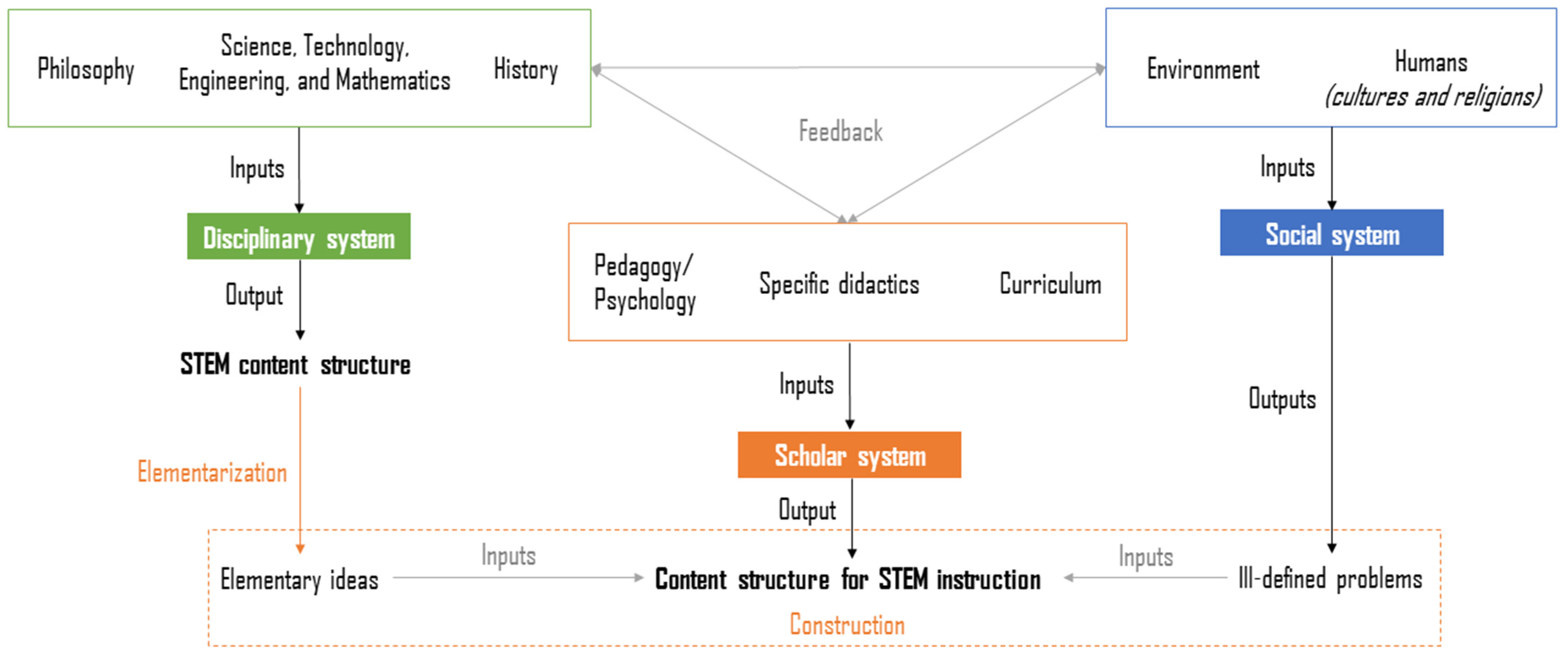
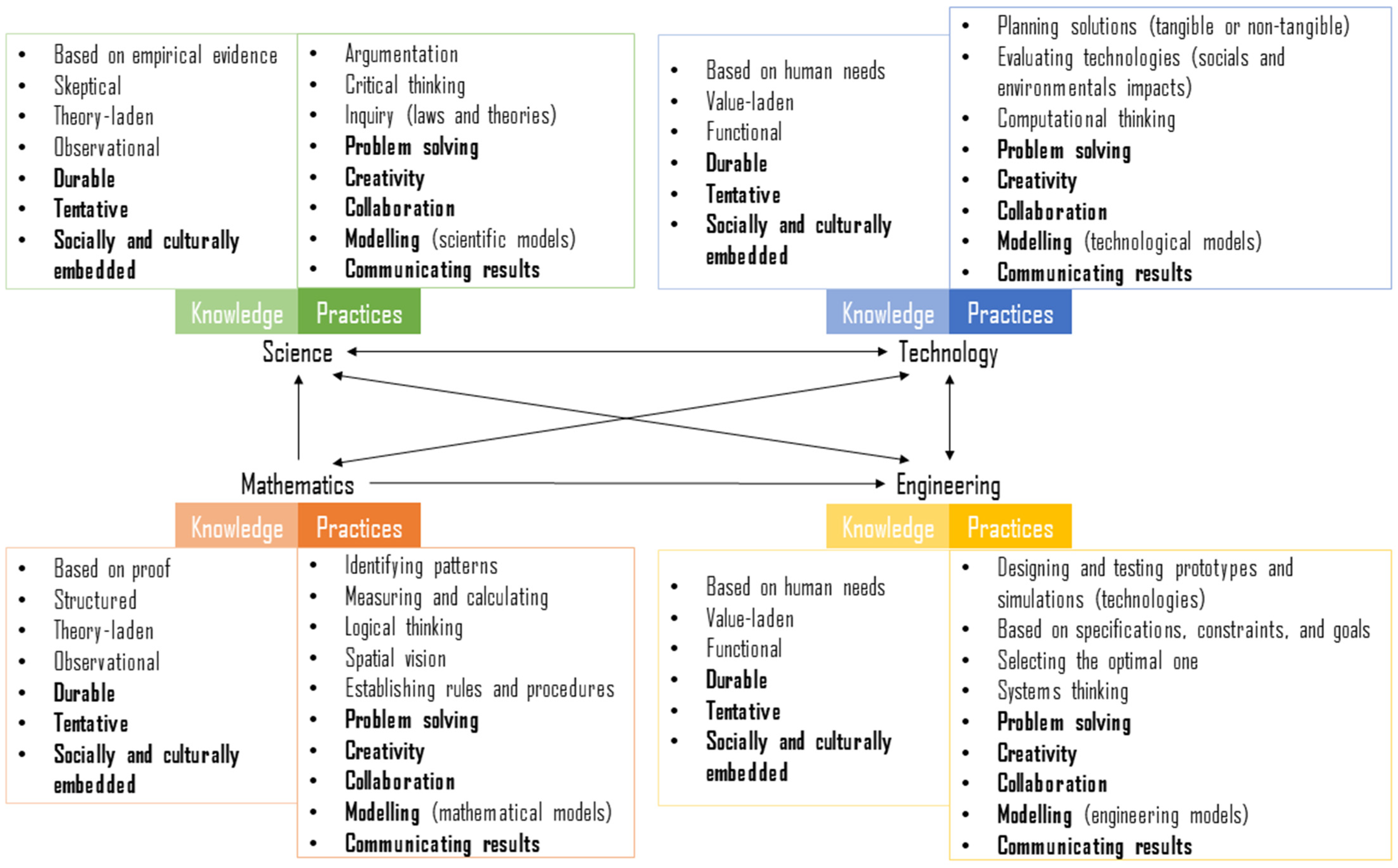
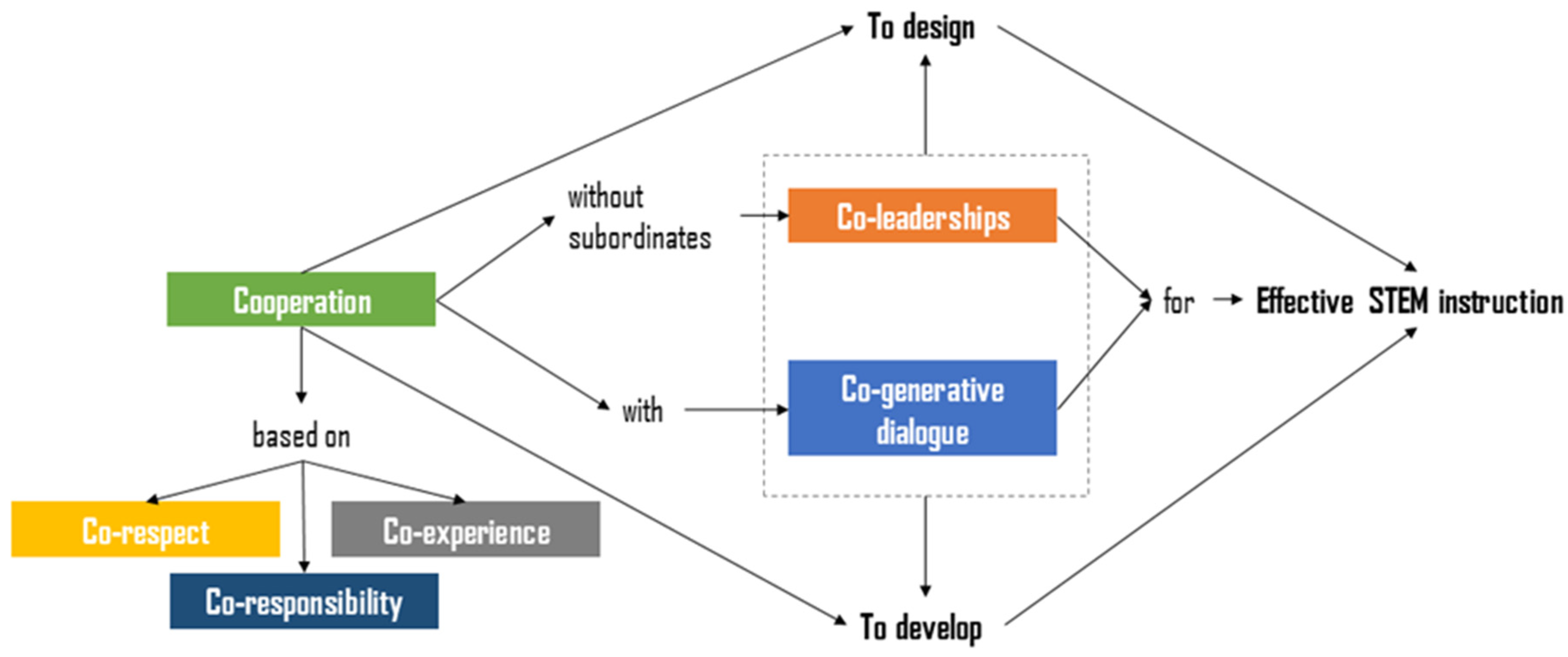
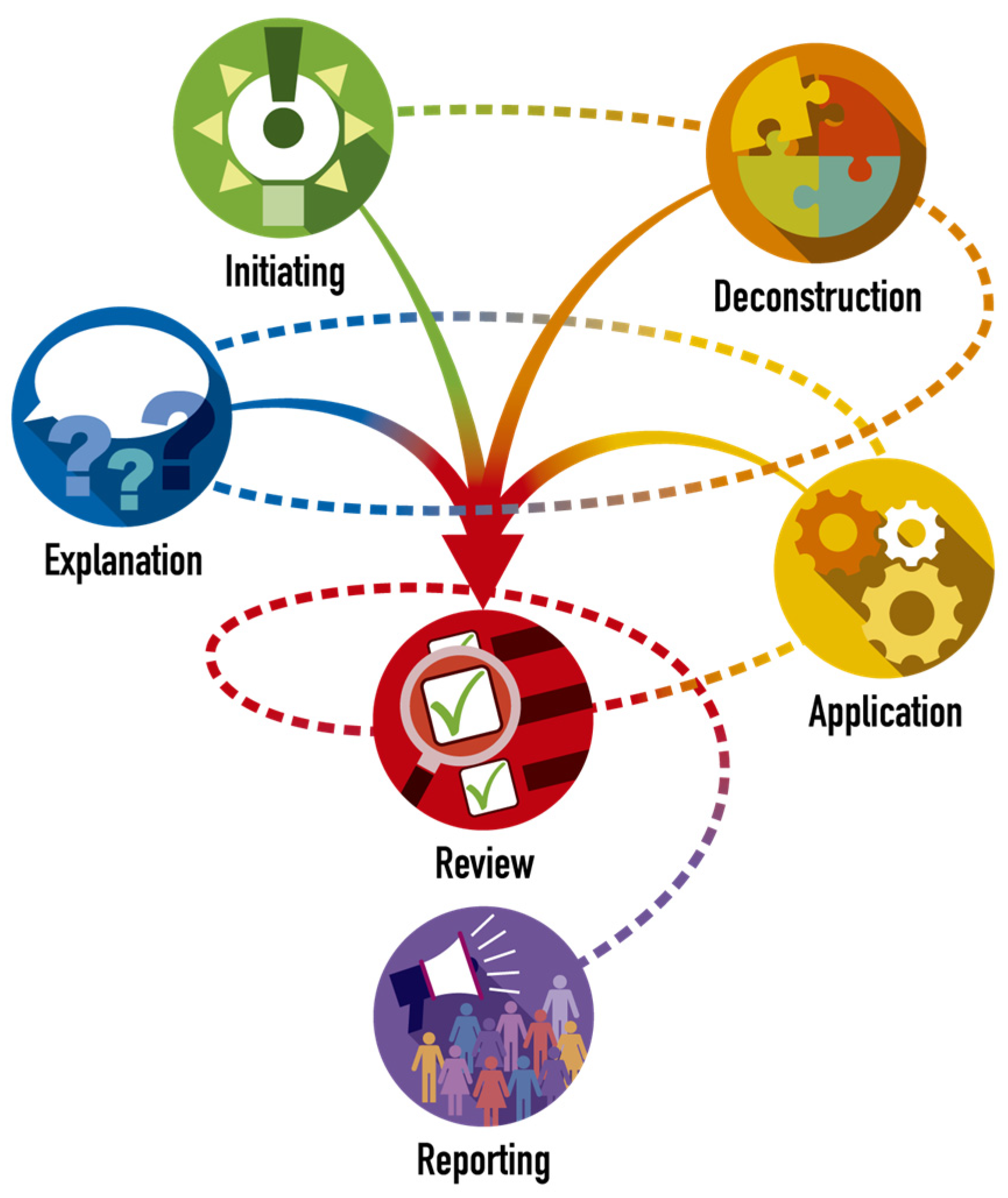

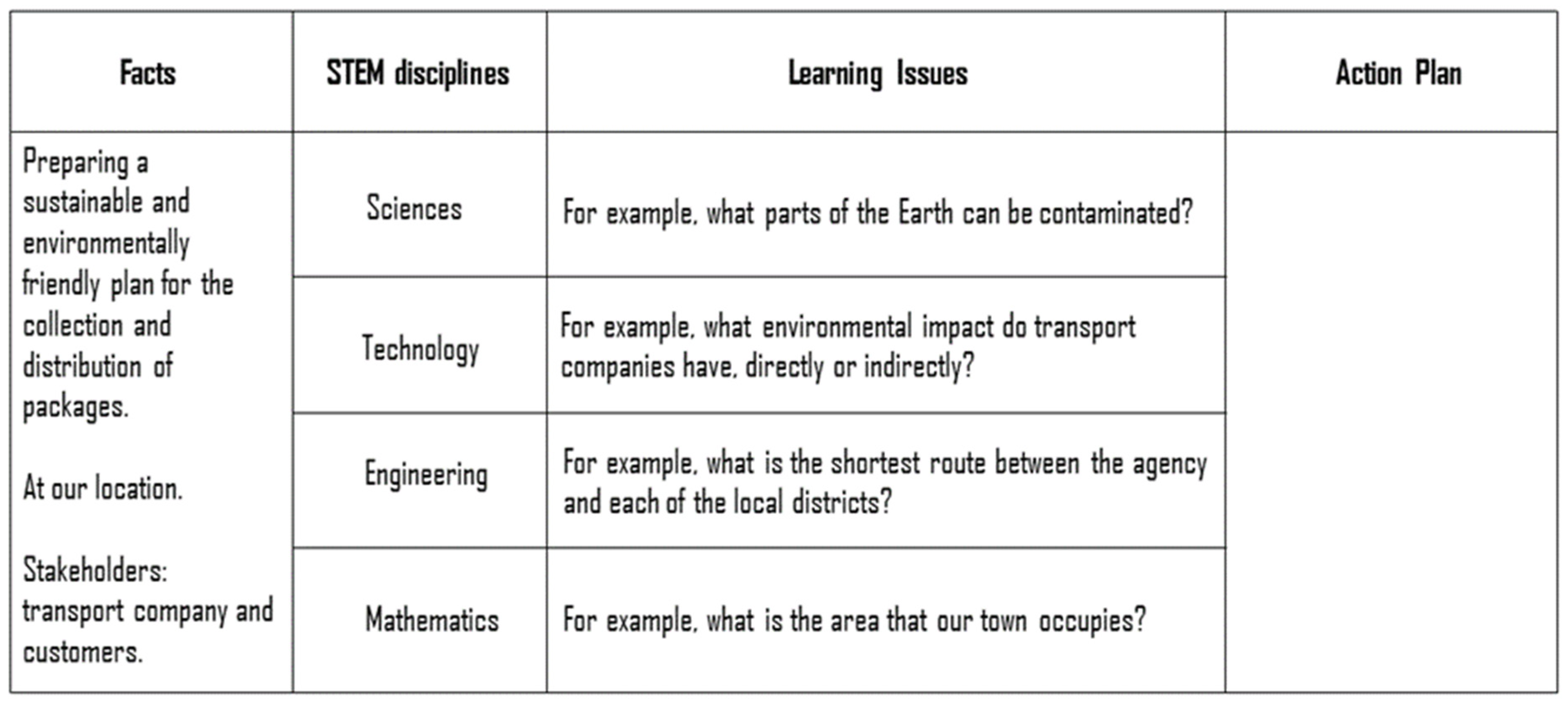
| Concepts | Definitions |
|---|---|
| STEM literacy | The ability to identify, apply, and integrate concepts from Science, Technology, Engineering, and Mathematics to understand complex problems and to innovate in order to solve them [25]. Bybee [26] specifies that this involves the following:
|
| STEM thinking | “As purposely thinking about how STEM concepts, principles and practices are connected to most of the products and systems we use in our daily lives” (p. 8) [27]. Therefore, this construct can be considered as part of STEM literacy. |
| STEM identity | As the extent to which a person sees themselves and is accepted as a member of a STEM discipline or field [28]. Therefore, it consists of four dimensions: (1) personal interest in STEM disciplines; (2) the ability to perform a task in the STEM field; (3) self-efficacy or beliefs about one’s capabilities to carry out a task in the STEM field; and (4) professional, academic, or personal aspirations in the STEM field [29]. |
| Factor | Definition |
|---|---|
| Cooperation | Teacher and co-teacher should collaborate and help each other [54]. |
| Co-experience | Teachers should share their knowledge about contents and related pedagogic experience, in order to enrich instruction with different teaching styles [55]. |
| Co-generative dialogue | Teachers should talk prior to class and during class. These talks should be aimed at solving problems related to the instructional process [56]. |
| Co-respect | Teachers should accept the presence, opinions, and help of peers [57]. |
| Co-responsibility | Teachers should feel involved in teaching planning, a fact that implies agreeing on content, strategies, and procedures (co-planning) [58]. |
| Co-leadership | No one should hold the role of main teacher or, on the contrary, subordinate [51]. |
| Discipline | Definitions |
|---|---|
| Science | A scientific explanation arises from the observation of the world around us. Therefore, it is the final product of a scientific process in which a natural phenomenon is described or explained—depending on whether it is a law or a theory—addressing how and why it occurs [67]. |
| Technology | A technological explanation focuses on the functions (behaviors) of the devised solution (prototype) for a specific problem, understanding it as part of a system. Therefore, it must consider its purposes and its impact (expected and/or verified) at the social and environmental levels [68]. |
| Engineering | An engineering explanation is oriented towards the functions (behaviors) of the devised solution (prototype) for a specific problem, arguing its creation based on the decisions made, project constraints, and limitations [69]. |
| Mathematics | A mathematical explanation is usually constructed from the observation of phenomena. Hence, it has traditionally been linked to scientific explanations, although explanatory processes also emerge within the discipline (e.g., the description of mathematical symbols). In essence, a mathematical explanation constitutes a repository of evidence describing a reality in the simplest and most truthful way. These pieces of evidence can consist of describing the rules of a specific calculation, analyzing a pattern or a variable, graphically representing patterns (e.g., graphs) or variables, statistical and probabilistic deductions, or structural descriptions (geometry) [70]. |
| IDEARR Stage | Practices | Justification |
|---|---|---|
| Initiating | Based on specifications, constraints, and goals; spatial vision | Once the problem is presented, it is advisable to establish the objectives and explore the scenario. As a result of these actions, specifications and constraints arise that will apply to the possible solutions to be achieved. |
| Deconstruction | Systems thinking; computational thinking; planning solutions; establishing rules and procedures | A holistic understanding of the problem is sought, so that it becomes part of a system in which different elements interact. Ultimately, to plan its solution, it will be necessary to establish “steps to follow”, along with alternative measures as contingency. All of this within the framework of pre-established or agreed-upon rules and general procedures during the planning. |
| Explanation | Inquiry; argumentation; logical thinking | An inquiry process begins, which could be empirical and would have its corresponding impact on the application phase. This process is aimed at obtaining explanations for the learning issues from the previous phase. Thus, logical thinking will be essential for linking simpler explanations and building complex (STEM) explanations. |
| Application | Designing and testing prototypes and simulations; selecting the optimal one; measuring and calculating | Prototypes are produced, selecting the option that best fits the established objectives. |
| Review | Critical thinking; evaluating technologies; identifying patterns | The cross-cutting nature of this phase creates small adjacent cycles that allow refining the outputs obtained in the other stages. Thus, a reflective process begins, aiming for improvement through critical and objective judgments. The produced technologies are evaluated, and patterns are analyzed to make better decisions. |
| Reporting | Communicating results (STEM practice) |
Disclaimer/Publisher’s Note: The statements, opinions and data contained in all publications are solely those of the individual author(s) and contributor(s) and not of MDPI and/or the editor(s). MDPI and/or the editor(s) disclaim responsibility for any injury to people or property resulting from any ideas, methods, instructions or products referred to in the content. |
© 2024 by the authors. Licensee MDPI, Basel, Switzerland. This article is an open access article distributed under the terms and conditions of the Creative Commons Attribution (CC BY) license (https://creativecommons.org/licenses/by/4.0/).
Share and Cite
Aguilera, D.; Lupiáñez, J.L.; Perales-Palacios, F.J.; Vílchez-González, J.M. IDEARR Model for STEM Education—A Framework Proposal. Educ. Sci. 2024, 14, 638. https://doi.org/10.3390/educsci14060638
Aguilera D, Lupiáñez JL, Perales-Palacios FJ, Vílchez-González JM. IDEARR Model for STEM Education—A Framework Proposal. Education Sciences. 2024; 14(6):638. https://doi.org/10.3390/educsci14060638
Chicago/Turabian StyleAguilera, David, José Luis Lupiáñez, Francisco Javier Perales-Palacios, and José Miguel Vílchez-González. 2024. "IDEARR Model for STEM Education—A Framework Proposal" Education Sciences 14, no. 6: 638. https://doi.org/10.3390/educsci14060638







